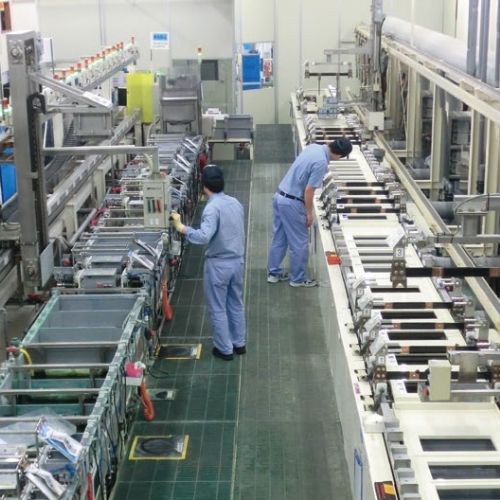As we enter the sixth year since the launch of Abenomics, Rich Lesser, President/CEO and visionary leader of worldwide consulting firm Boston Consulting Group (BCG), gives us his assessment of Japan’s economy and his thoughts on its future prospects.
Rich Lesser
President and CEO of BCG; previously served as Chairman of North and South America. Under his leadership, BCG has continued its strong global growth across all regions and practices, fueled by investments in new offices, digital and analytics, and capabilities to drive transformation. Member of several leading organizations, such as the WEF’s International Business Council and the US Business Roundtable. Has also sustained BCG’s investments in social impact through its many partnerships including the World Food Programme, Save the Children, Teach for All, and WWF.
Japan’s economy was in full bloom from the 1960s through the 1980s, its post-war recovery deemed a miracle. And it wasn’t simply a rebound. Japanese companies were at the forefront of business innovation. In fact, one of BCG’s seminal concepts, time-based competition, was inspired by Japanese companies and their pioneering approach to flexible manufacturing.
The era of double-digit growth, however, is a distant memory. For more than two decades, Japan has been trying to reverse an economic downturn. Although the problems run deep, recent policies have been transformative—they’ve stabilized the economy and laid the groundwork for sustained growth. To keep the momentum going, leaders will have to continue pushing existing reforms while taking a fresh look at a set of emerging priorities for both business and society.
Abenomics has provided a foundation for growth
Japan is dealing with many of the same challenges confronting other developed countries: namely, an aging and shrinking workforce and population and a mature, high-cost industrial base. As a result, the country now faces pincer competition, with pressure coming from lower cost nations on the one hand and disruptive new players from the digital economy on the other. At the same time, the government is in the difficult position of trying to balance declining income with the increasing costs associated with higher dependency ratios and an aging population.
As vexing as such constraints may be, they can be powerful catalysts for the kind of bold adaptation and innovation that can revitalize a country’s competitiveness. Under the Abe administration and its agenda of Abenomics, Japan has confronted its structural issues head-on.
Monetary and fiscal policy, two of the “three arrows” of Abenomics, have been used effectively. Monetary policy helped reverse deflationary and negative price trends, while fiscal policy bolstered domestic demand, with supplementary budgets totaling JPY 36 trillion (USD 319 billion) since the start of the Abe administration in 2012. As a result, companies have regained confidence and the economy is growing again. Japan has managed to do this while avoiding the social divisions created by the inequality of opportunity or earning potential in the U.S. and Europe.
Both outbound M&A and corporate profits have hit record highs. The former is a sign of companies’ increasing appetite for growth. The latter stems from the steady improvement of ROA, which stands in contrast to flat or decreasing ROA in the U.S. and Europe. The economic outlook, in general, is optimistic. In my discussions with Japanese CEOs, I’ve sensed growing confidence in the revitalization of demand.
The third arrow of Abenomics—a series of structural reforms—is poised to have an equally profound effect. Since 2012, structural reforms have moved beyond priority industries to encompass a broader transformational agenda, which includes initiatives to accelerate innovation, increase the participation of women and seniors in the workforce, and expand strategic growth opportunities. The government also set out a sweeping vision for what it calls “Society 5.0,” which looks at how technologies such as artificial intelligence, big data, and the Internet of Things will transform how people live and work.
More challenges—and opportunities—lie ahead
To build on the momentum generated by Abenomics and avoid losing any ground gained over the past few years, policymakers and business leaders should focus on three critical areas, all of which are relevant to developed economies, in general.
Corporate vitality. Having record corporate profits at a time when there is an urgent need to invest in new technologies and next-generation manufacturing raises an important question: Are companies doing enough to sow the seeds for future success? To ensure industrial and national competitiveness, corporate transformation needs to be pursued aggressively, with a focus on upgrading the industrial base and harnessing the power of AI and the Internet of Things. Our recent work with Fortune showed that corporate vitality—the capacity for growth and reinvention—is driven by strategic mindset, technology investment, and managerial renewal.
Diversity and innovation. The aging and shrinking workforce will raise the controversial issues of immigration, equal opportunity, and diversity policies. A soon-to-be-published BCG study, based on an analysis of 1,700 companies in eight nations, shows that diversity drives innovation, as measured by the proportion of revenues derived from newer products. Moreover, companies that broaden their approach to diversity—they include aspects such as age, gender, industry background, nationality, and career path—see bigger benefits. The diversity effect is also greater for digital innovation. When we looked at enabling factors like managerial support for diversity, equal opportunity policies, and open communication, we found that less than 40% of companies had these in place, suggesting a huge upside for companies and nations willing to embrace the diversity agenda.
Value-based health care. Japan enjoys relatively good health care outcomes at a reasonable per capita cost, thanks to universal access, a single payer system, and strict cost control. But with the rapid evolution of medical technology, expectations for access to this technology, and the realities of an aging population, cost containment alone will not be sufficient. Our studies have shown the effectiveness of value-based health care, where the costs and outcomes of different interventions are measured, shared, and used to guide the selection of therapies across the health care system. This is a tough change-management challenge, but one that Japan has every incentive to pioneer.
Japan has an enviable heritage of innovation. We are confident and hopeful that if the tough constraints of the future are embraced with the same courage and cohesiveness that the Japanese government and people have shown to date, Japan can become both a pioneer in building an economy and society for the next generation—with a focus on diversity, renewal, and technology—and a beacon for other nations that will eventually face the same pressures.






























